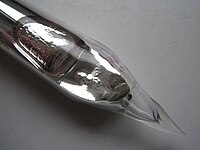
Photo from wikipedia
Abstract The alum-treated Viking Age archaeological wooden objects from the Oseberg find have undergone extensive chemical deterioration due to the original conservation treatment, based on alum salts (KAl(SO4)2·12H2O), done in… Click to show full abstract
Abstract The alum-treated Viking Age archaeological wooden objects from the Oseberg find have undergone extensive chemical deterioration due to the original conservation treatment, based on alum salts (KAl(SO4)2·12H2O), done in the early 1900s. Today, the artifacts are highly acidic (pH≤2) and fragile; in some cases wood has almost completely lost its structural integrity. Research on conservation methods for these finds is currently underway. In the present study, organic/inorganic multi-functional ‘hybrid systems’ – using propylene glycol modified TEOS and alkaline nanoparticles (Ca(OH)2) – have been engineered to deacidify and consolidate alum-treated wood in a single step. The advantage of using silicon monomer and nano-materials as a starting point resides in their ease of penetration into the wood structure, where silicon monomers subsequently undergo polymerization. Treated samples were investigated using thermal analysis (DTG), X-Ray Diffraction (XRD), infrared spectroscopy (ATR-FTIR), SEM/EDX and Gas Chromatography Mass Spectroscopy (GC-MS). Results suggest that in addition to consolidating the wood, alkoxysilanes could act as a bridging agent between remaining lignin and calcium hydroxide nanoparticles.
Journal Title: Pure and Applied Chemistry
Year Published: 2017
Link to full text (if available)
Share on Social Media: Sign Up to like & get
recommendations!